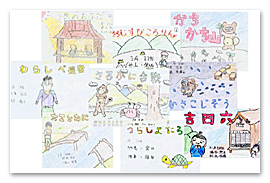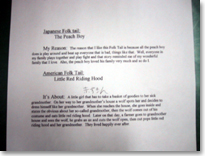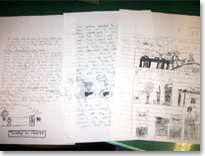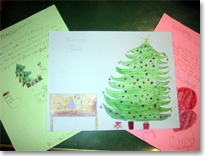|
|
| (2) |
�gLet�fs
exchange our folk tales using picture-story shows.�h�|Let�fs hear
impressions about the stories from friends in the world. |
| |
| 1) |
Objectives and aims
Our students and the students at our partnership junior
high school create picture-story shows of their own countries�f
folk tales, and exchange them.
| �@ |
To learn about each other�fs culture
from the picture-story shows. (Ways of living, ways
of thinking, natural and geographical conditions,
history, and so on.) |
| �A |
To learn and improve English translation
and comprehension skills. |
| �B |
To understand how picture-story
shows, picture books, and folk tales are constructed.
(Scenes, a story teller, logic of writing, and so
on.) |
| �C |
To work together to create a
work and introduce a work sent from the partner
school. |
|
| |
|
| 2) |
Contents |
| |
| �@ |
Students visit the �gdigital picture
book website�h and read folk tales from the world.
http://www.e-hon.jp/ |
| �A |
Students suggest to the partner
school the idea of �gcreating picture-story shows
of our own country�fs folk tales and exchange them.�h |
| �B |
Students visit the �gJapanese
folk tales�h in the �gdigital picture book website,�h
read the English-translated tales, and comprehend
the English contents by comparing the Japanese version
and the English-translated version. |
| �C |
Students decide which story to
base their group�fs picture-story show on.
��Japanese folk tales on the �gdigital picture book
website�h that are already translated into English
should be excluded. |
| �D |
Students understand how picture-story
shows, picture books, and folk tales are constructed. |
| �E |
Students decide an organization,
a plan, and role divisions. |
| �F |
Students make picture-story shows. |
| �G |
Students send their picture-story
shows to the partner school with a letter. |
| �H |
Students read picture-story shows
mailed from the partner school and translate them
into Japanese. |
| �I |
Students hold a show of �gWorld�fs
picture-story shows�h to introduce and appreciate
different picture-story shows with friends. (Using
picture-story shows distributed among groups) |
|
| |
|
| 3) |
Steps and contents of the exchange
We posted picture-story shows made by our students to
the website as part of the JEARN�fs Falk tale project,
and created The Picture Story Show website (http://www2.jearn.jp/fs/1151/index.html).
We asked the public for their opinions about the picture-story
shows and what they think should be improved. We also
asked them to introduce their own countries�f folk tales
and old tales.
With the help from the International Student Center at
Hiroshima University, we also asked international students
at the university for their opinions about the picture-story
shows. We got responses from the following.
�@ Martin Middle School (USA)
�A Katherine High School (Australia)
�B Radford College(Australia)
�C Schools joining JEARN (N.Y. and others)
�D International students at Hiroshima University
�E Others |
| |
|
| 4) |
Outcomes and issues for the future
We received many responses from students at Martin Middle
School about the picture-story shows. The majority said
�gthe drawings were pretty, and it was interesting to see
animals to be main characters.�h Many of the responses
were compliments about the drawings, which indicates that
they liked light touches of the drawings which our students
drew with colored pencils. On the other hand, the majority
of the critical comments was that they could not follow
the development of the story line and did not understand
the meaning of the story, such as �gI don�ft understand
the development, the story is difficult to understand,
I can�ft see why the story ended like that.�h This result
reflects our students�f lack of English skills as well
as poor use of Japanese expressions. However, since our
objective of the first picture-story show website was
�gto clarify what we should be careful about in order to
improve picture-story shows and introduce Japanese picture-story
shows in English, as well as to learn what should be improved,�h
receiving many responses was encouraging for our students.
Receiving these comments, students revised the picture-story
shows and managed to complete them.
Furthermore, many students at Martin Middle School introduced
popular folk tales in America, many of which our students
had never heard about before. Therefore, our students
read the letters with a great interest, and many of them
wrote a reply letter. |
|
|
| |
(Material 1 Top
page of the picture-story show website ��Some parts were omitted.)
Produced by Mihara J.H.S in the 7thgrade students

|
|
| |
(Material 2 E-mails
that we received)
| �iAustralia 1�j |
| �͂��߂܂��āB�킽���̓j�R�ł��B�킽���͏\�O�����ł��B�킽���͒��w�B���͂Ȃ�����݂܂����B�ƂĂ����܂��������ł��B����Ȃ��͂Ȃ���three
cards�ł��B���肪�Ƃ��������܂����BHello students, I enjoyed your stories
very much.The three cards pictures are very good and detailed! |
| �iAustralia 2�j |
�͂��߂܂��āB�킽���@�́@Chloe
����@�ł��B�\�l�@�����@�ł��B���イ�����@�Ɂ@�Ȃ�@�����@�ł��B���@�͂Ȃ��@���@��݂܁@���@���B��@��@�����@�ȁ@���͂Ȃ��@�́@fire
raccoon dog ��the rolling rice ball.Your stories were great!
I loved them! You are all really good at English.My friends
and I found them really fun and interesting to read. We
enjoyed reading them thoroughly. You are all really talented
drawers, your pictures were very colourful and pretty
to look at.Your translation of the stories were very good,
and the wording you used was flowing and easy to understand.
I liked all of your stories they were great!
���肪�Ƃ��������܂����B |
| �iFrom Ed in N.Y.)�j |
| The picture shows
are great, very expressive and colorful. I have known
some of these stories before, but they came alive when
I saw your students' pictures. I hope your students will
tell us about drawing these pictures? What did you learn
and what are you trying to share with us outside Japan?
What do these stories tell us about Japanese history and
culture? I would love to hear from your students. From
Ed New York City |
(From Martin Middle School) ��The following is a part of letters
that we received.
 |
|
 |
| ��Opinions about folk tales |
|
��Introducing stories told
in America |
 |
|
 |
| ��An event in America 1 |
|
��Introducing the student�fs favorite
event |
|
|
|

